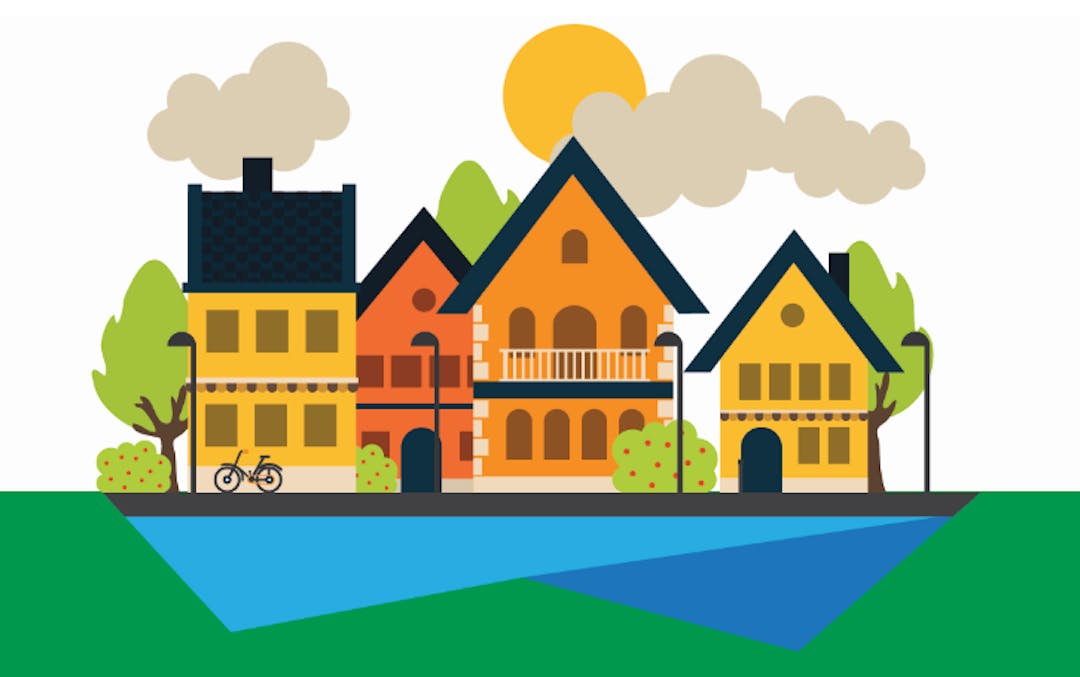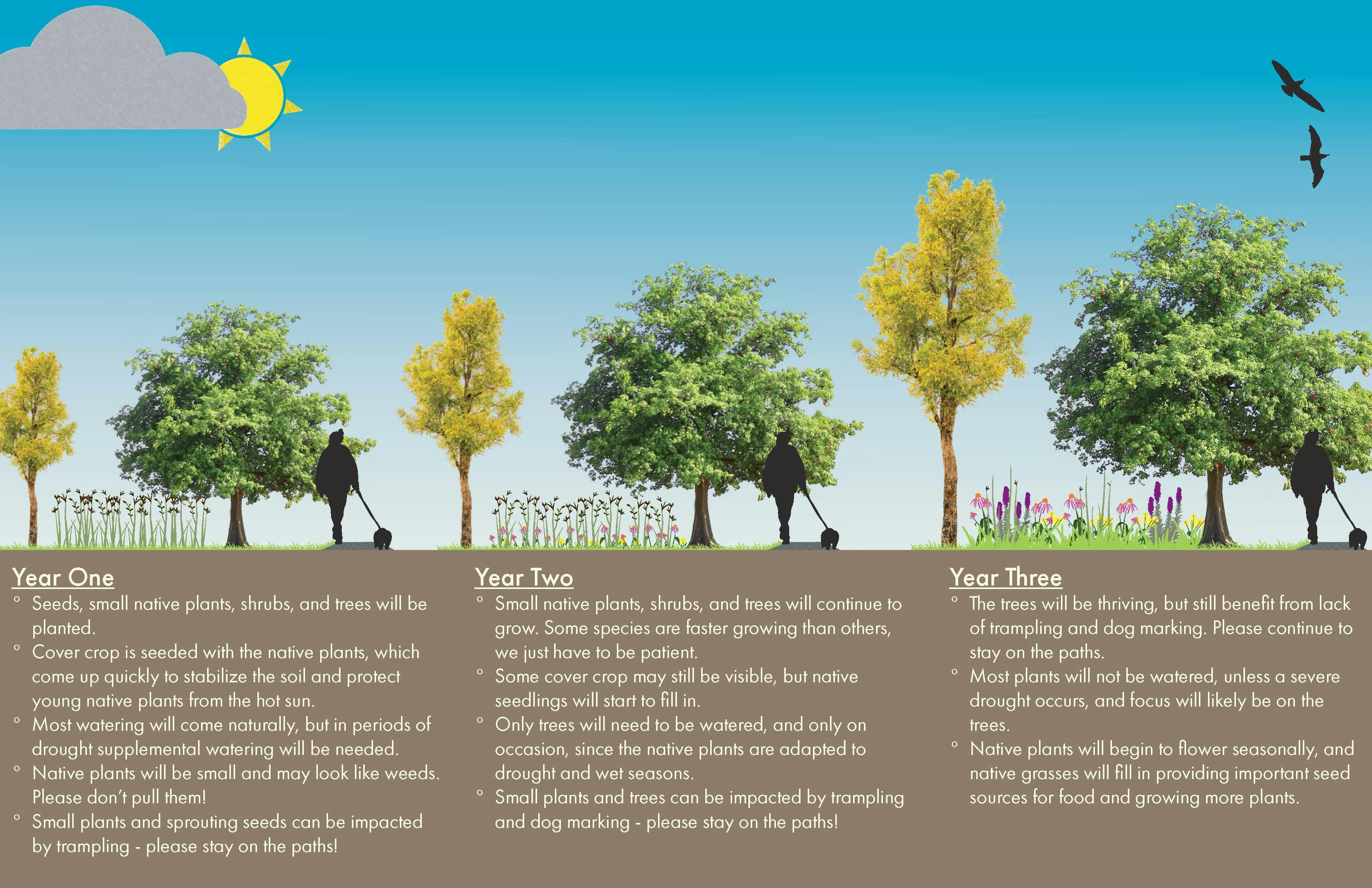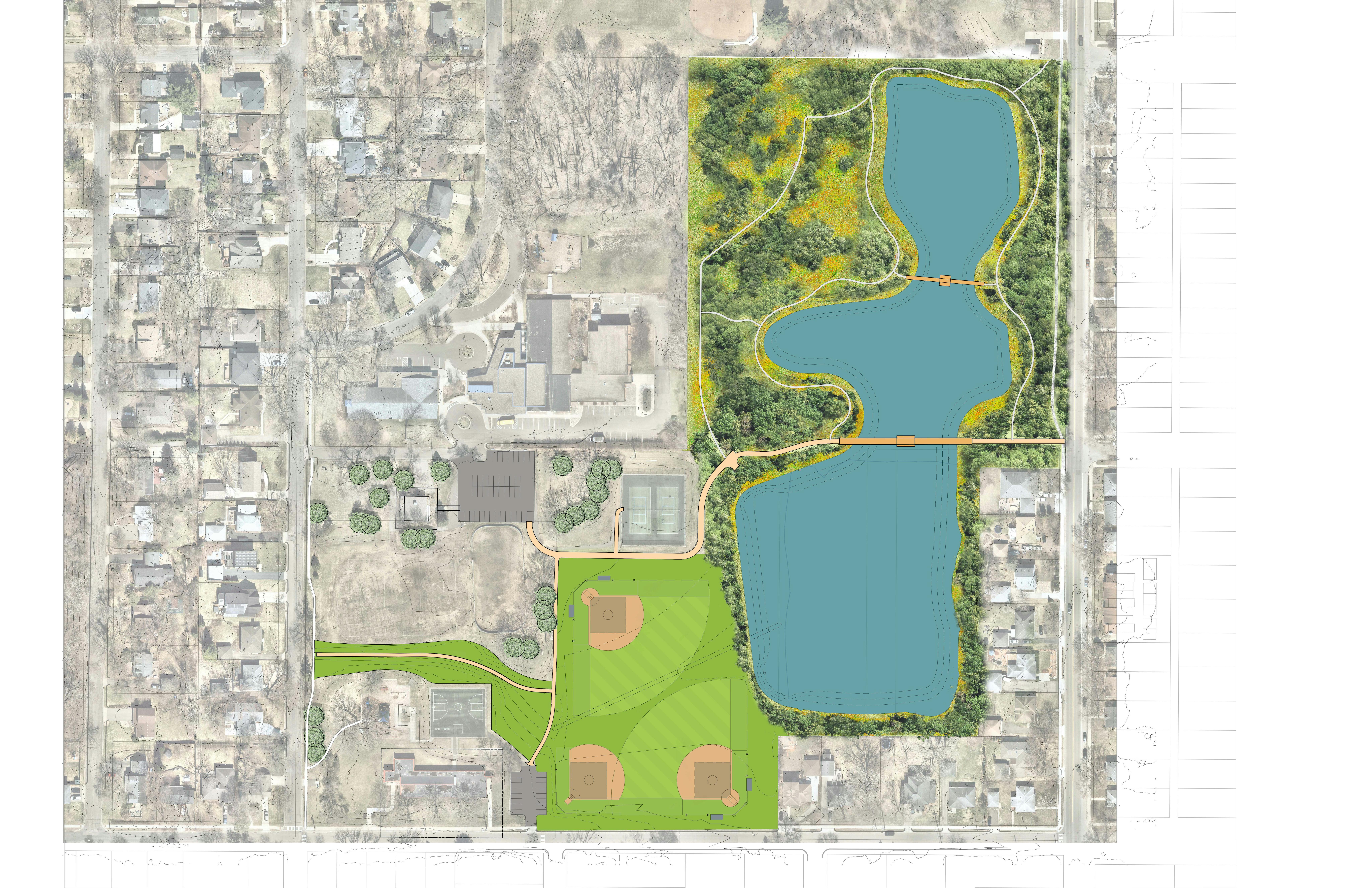Morningside Flood Infrastructure Project
This project has been completed and this project page will no longer be updated. Please contact staff with any questions or comments. Thank you.

The Morningside Neighborhood has several low and landlocked areas prone to flooding. Climate change has already increased the risk of flooding and will continue to do so. This project helps the community be more resilient to flooding. Project benefits are balanced across the neighborhood and there is no increase in risk to any property.
Ponds, pipes and a surface swale will be used to safely move and store floodwaters. An expanded pipe and swale will provide overflow from the Lynn/Kipling inundation area and the Grimes Avenue low point, and an expanded and reconfigured pipe network and minor grade changes will move water away from homes. Weber Pond and the Lynn/Kipling Pond will be expanded and lowered. About six acres of trees will be removed in Weber Woods to accommodate the larger ponds.
The flood infrastructure project also includes:
- Natural resources restoration in upland areas.
- Nature trails and bridge crossings at two locations at Weber Park.
- Improved pedestrian access to the park with some ADA-compliant paths in Weber Park.
- Rebuilt sports fields in impacted areas with new turf and irrigation systems.
The flood infrastructure project coincides with planned roadway reconstruction in the neighborhood in 2022 and 2023.
The Morningside Neighborhood has several low and landlocked areas prone to flooding. Climate change has already increased the risk of flooding and will continue to do so. This project helps the community be more resilient to flooding. Project benefits are balanced across the neighborhood and there is no increase in risk to any property.
Ponds, pipes and a surface swale will be used to safely move and store floodwaters. An expanded pipe and swale will provide overflow from the Lynn/Kipling inundation area and the Grimes Avenue low point, and an expanded and reconfigured pipe network and minor grade changes will move water away from homes. Weber Pond and the Lynn/Kipling Pond will be expanded and lowered. About six acres of trees will be removed in Weber Woods to accommodate the larger ponds.
The flood infrastructure project also includes:
- Natural resources restoration in upland areas.
- Nature trails and bridge crossings at two locations at Weber Park.
- Improved pedestrian access to the park with some ADA-compliant paths in Weber Park.
- Rebuilt sports fields in impacted areas with new turf and irrigation systems.
The flood infrastructure project coincides with planned roadway reconstruction in the neighborhood in 2022 and 2023.
This project has been completed and this project page will no longer be updated. Please contact staff with any questions or comments. Thank you.
-
Today's storm
Share Today's storm on Facebook Share Today's storm on Twitter Share Today's storm on Linkedin Email Today's storm linkToday's storm is predicted at 2" of rainfall. The real time control system opened up 9" of storage last night ahead of the wet weather event.
-
Garlic Mustard control today
Share Garlic Mustard control today on Facebook Share Garlic Mustard control today on Twitter Share Garlic Mustard control today on Linkedin Email Garlic Mustard control today linkCrews were on site today doing spot applications of herbicide to control garlic mustard.
Garlic mustard is a non-native plant. Garlic mustard forms thick mats that shade and outcompete native plant species and it can impede natural forest regeneration by producing chemicals that reduce growth of other plants. DNR Garlic Mustard Information Page.
-
Save the Date: July 11 Ribbon-Cutting Ceremony
Share Save the Date: July 11 Ribbon-Cutting Ceremony on Facebook Share Save the Date: July 11 Ribbon-Cutting Ceremony on Twitter Share Save the Date: July 11 Ribbon-Cutting Ceremony on Linkedin Email Save the Date: July 11 Ribbon-Cutting Ceremony linkA ribbon-cutting ceremony will be held July 11th. More details on the time and location will be provided as they are finalized.
-
Weed control site visit
Share Weed control site visit on Facebook Share Weed control site visit on Twitter Share Weed control site visit on Linkedin Email Weed control site visit linkCrews were on site last Friday to do an herbicide treatment to control weeds. People and pets should keep out of the sprayed areas. Areas treated with herbicide are marked with bright yellow utility flags.
-
Tree warranty replacements
Share Tree warranty replacements on Facebook Share Tree warranty replacements on Twitter Share Tree warranty replacements on Linkedin Email Tree warranty replacements linkThe majority of tree warranty replacements have been completed. The remaining replacements are bare root trees which will be available and planted next summer.

-
Natives - Part 4
Share Natives - Part 4 on Facebook Share Natives - Part 4 on Twitter Share Natives - Part 4 on Linkedin Email Natives - Part 4 link Blue vervain
Blue vervain Butterfly milkweed
Butterfly milkweed Black-eyed Susan
Black-eyed Susan -
Natives - Part 3
Share Natives - Part 3 on Facebook Share Natives - Part 3 on Twitter Share Natives - Part 3 on Linkedin Email Natives - Part 3 link Horsemint
Horsemint
 Horsemint
Horsemint American black currant
American black currant -
Natives - Part 2
Share Natives - Part 2 on Facebook Share Natives - Part 2 on Twitter Share Natives - Part 2 on Linkedin Email Natives - Part 2 link Arrowhead
Arrowhead  Red-twigged dogwood
Red-twigged dogwood  Blue monkey-flower
Blue monkey-flower -
Natives - Part 1
Share Natives - Part 1 on Facebook Share Natives - Part 1 on Twitter Share Natives - Part 1 on Linkedin Email Natives - Part 1 linkWe admit, it's a bit weedy out there. That's to be expected in the first year of a restoration project. We've also been able to spot some nice natives that seem to be doing well.
 Patridge Pea
Patridge Pea Spotted jewelweed
Spotted jewelweed Columbine
Columbine -
Temporary fencing
Share Temporary fencing on Facebook Share Temporary fencing on Twitter Share Temporary fencing on Linkedin Email Temporary fencing linkTemporary fencing was installed earlier this summer to protect trees and restoration areas during this initial phase when new plants are most vulnerable. Please continue to keep to the paths.
Who's Listening
-
Phone 952-903-5713 Email RBintner@EdinaMN.gov -
Phone 952-826-0445 Email JWilson@EdinaMN.gov -
Phone 952-826-0317 Email TSwenson@EdinaMN.gov
Key Dates
-
July 11 2024
-
October 19 2021
-
September 21 2021
Photos
Lifecycle
-
Share Information
Morningside Flood Infrastructure Project has finished this stageSummer 2020
Information about flood risk, Edina's Flood Risk Reduction Strategy, and actions people can take to reduce their own flood risk will be shared.
-
Present Initial Concepts
Morningside Flood Infrastructure Project has finished this stageFall 2020
Initial concepts will be presented for feedback.
-
Present Refined Concepts
Morningside Flood Infrastructure Project has finished this stageWinter 2020
Refined concepts based on feedback will be presented.
-
Make a Decision
Morningside Flood Infrastructure Project has finished this stageSpring 2021
Staff will make a recommendation and City Council will make a decision.
-
Close the Loop - Concept Design Phase
Morningside Flood Infrastructure Project has finished this stageSpring 2021
The decision will be communicated to the public and archived on the Better Together Edina project page.
-
Added: Detailed Engineering and Landscape Design Begins
Morningside Flood Infrastructure Project has finished this stageSpring 2021
City Council approved the project at their April 20th, 2021 meeting. This moved the project from the concept design phase to the detailed engineering and landscape design phase.
-
Added: Present Landscape Design
Morningside Flood Infrastructure Project has finished this stageSummer 2021
An initial version of the design (at 30% completion) will be presented for feedback.
-
Added: Make a Decision
Morningside Flood Infrastructure Project has finished this stageFall 2021
Staff will make a recommendation and City Council will make a decision.
-
Added: Design
Morningside Flood Infrastructure Project has finished this stageFall 2021 - Winter 2022
Staff will complete the design and prepare construction bid documents.
-
Added: Construction Phase 1
Morningside Flood Infrastructure Project has finished this stageWinter 2022
Tree removal.
-
Added: Construction Phase 2
Morningside Flood Infrastructure Project has finished this stageSpring 2022 - early Winter 2023
Grading and excavation to create flood storage.
Upstream pipe capacity work will occur as part of the street reconstruction projects in 2022 and 2023.
-
Added: Construction Phase 3 - Park Restoration
Morningside Flood Infrastructure Project is currently at this stageFall 2022 - Summer 2023
Turf restoration, natural resource restoration, and tree planting.
Related projects
Documents
-
 MFIP_Outcomes_How it works.pdf (9.18 MB) (pdf)
MFIP_Outcomes_How it works.pdf (9.18 MB) (pdf)
-
 MFIP_Outcomes_Boards.pdf (10.1 MB) (pdf)
MFIP_Outcomes_Boards.pdf (10.1 MB) (pdf)
-
 Weber Park Scavenger Hunt Map.pdf (2.71 MB) (pdf)
Weber Park Scavenger Hunt Map.pdf (2.71 MB) (pdf)
-
 Restoration Phase Graphic.pdf (5.39 MB) (pdf)
Restoration Phase Graphic.pdf (5.39 MB) (pdf)
-
 2022_Morningside-Flood-Infrastructure_FAQs.pdf (353 KB) (pdf)
2022_Morningside-Flood-Infrastructure_FAQs.pdf (353 KB) (pdf)
-
 Final park plan_Feb2022.pdf (6.81 MB) (pdf)
Final park plan_Feb2022.pdf (6.81 MB) (pdf)
-
 Park Birds Eye View Feb2022.pdf (2.53 MB) (pdf)
Park Birds Eye View Feb2022.pdf (2.53 MB) (pdf)
-
 Pond boardwalk rendering Feb2022.pdf (1.75 MB) (pdf)
Pond boardwalk rendering Feb2022.pdf (1.75 MB) (pdf)
-
 Lynn Kipling Pond Plan_Feb2022.pdf (2.8 MB) (pdf)
Lynn Kipling Pond Plan_Feb2022.pdf (2.8 MB) (pdf)
-
 Edition Edina_Feb2022.pdf (1.95 MB) (pdf)
Edition Edina_Feb2022.pdf (1.95 MB) (pdf)
-
 Ecological Quality Assessment Report_2021.pdf (1.68 MB) (pdf)
Ecological Quality Assessment Report_2021.pdf (1.68 MB) (pdf)
-
 Morningside_Habitat_Plan.pdf (6.27 MB) (pdf)
Morningside_Habitat_Plan.pdf (6.27 MB) (pdf)
-
 maps
maps
-
 concept development
concept development
-
 Edina's Flood Risk Reduction Strategy report (21.6 MB) (pdf)
Edina's Flood Risk Reduction Strategy report (21.6 MB) (pdf)
-
 Public Participation Plan (177 KB) (pdf)
Public Participation Plan (177 KB) (pdf)
-
 Anticipated Project Timeline - as of June 3, 2020 (2.33 MB) (jpg)
Anticipated Project Timeline - as of June 3, 2020 (2.33 MB) (jpg)
-
 June 3, 2020 presentation (2.33 MB) (pdf)
June 3, 2020 presentation (2.33 MB) (pdf)
-
 Survey 1 results.jpg (98.5 KB) (jpg)
Survey 1 results.jpg (98.5 KB) (jpg)
-
 September 3, 2020 presentation (10.4 MB) (pdf)
September 3, 2020 presentation (10.4 MB) (pdf)
-
 Morningside_Flood_Infrastructure_Technical_Memo_Oct2020.pdf (10.7 MB) (pdf)
Morningside_Flood_Infrastructure_Technical_Memo_Oct2020.pdf (10.7 MB) (pdf)
-
 Infrastructure Scenarios_Oct2020.pdf (12.4 MB) (pdf)
Infrastructure Scenarios_Oct2020.pdf (12.4 MB) (pdf)
-
 December 9, 2020 presentation (3.2 MB) (pdf)
December 9, 2020 presentation (3.2 MB) (pdf)
-
 Engagement Report_January 2021 (17.3 MB) (pdf)
Engagement Report_January 2021 (17.3 MB) (pdf)
-
 Technical_Memo_Feb2021.pdf (7.04 MB) (pdf)
Technical_Memo_Feb2021.pdf (7.04 MB) (pdf)
-
 DRAFT Preliminary Report_March 16 Work Session.pdf (1.92 MB) (pdf)
DRAFT Preliminary Report_March 16 Work Session.pdf (1.92 MB) (pdf)
-
 FINALIZED Preliminary Report_March 16 Work Session.pdf (1.79 MB) (pdf)
FINALIZED Preliminary Report_March 16 Work Session.pdf (1.79 MB) (pdf)
-
 Staff Report_April 20 2021 (793 KB) (pdf)
Staff Report_April 20 2021 (793 KB) (pdf)
-
-
 30% design
30% design
-
 Eng&Landscape Design Public Participation Plan (167 KB) (pdf)
Eng&Landscape Design Public Participation Plan (167 KB) (pdf)
-
 Morningside 30%Plan.pdf (4.82 MB) (pdf)
Morningside 30%Plan.pdf (4.82 MB) (pdf)
-
 Morningside 30%Imagery.pdf (5.35 MB) (pdf)
Morningside 30%Imagery.pdf (5.35 MB) (pdf)
-
 Morningside 30%Timeline_LK.pdf (3.71 MB) (pdf)
Morningside 30%Timeline_LK.pdf (3.71 MB) (pdf)
-
 Sept 21, 2021 City Council Presentation.pdf (6.1 MB) (pdf)
Sept 21, 2021 City Council Presentation.pdf (6.1 MB) (pdf)
-
 Sept 21, 2021 Staff Report.pdf (318 KB) (pdf)
Sept 21, 2021 Staff Report.pdf (318 KB) (pdf)
-
 Revised Morningside 30%Plan.pdf (13.7 MB) (pdf)
Revised Morningside 30%Plan.pdf (13.7 MB) (pdf)
-
 Stakeholder Engagement Report_Oct2021 (610 KB) (pdf)
Stakeholder Engagement Report_Oct2021 (610 KB) (pdf)
-
 Stakeholder Engagement Report_Appendix (1.63 MB) (pdf)
Stakeholder Engagement Report_Appendix (1.63 MB) (pdf)
-
Videos
-
Click here to play video Weber Park Ribbon Cutting Reel Weber Park Ribbon Cutting Ceremony, July 11 , 2024
-
 Click here to play video
Morningside Project (starts at 3 min mark) 30% approval summary
Morningside Project (starts at 3 min mark) 30% approval summary
Click here to play video
Morningside Project (starts at 3 min mark) 30% approval summary
Morningside Project (starts at 3 min mark) 30% approval summary
-
 Click here to play video
Flood Risk in the Morningside Neighborhood - a closer look
A closer look at the flooding problems in the Morningside Neighborhood.
Click here to play video
Flood Risk in the Morningside Neighborhood - a closer look
A closer look at the flooding problems in the Morningside Neighborhood.
-
 Click here to play video
Flood Risk in the Morningside Neighborhood
An overview of how and where flooding happens.
Click here to play video
Flood Risk in the Morningside Neighborhood
An overview of how and where flooding happens.















